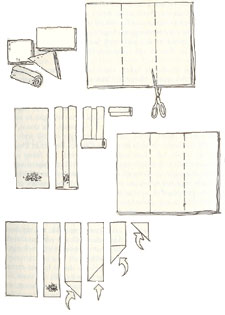| |
How to work with "PHYLLO" |
|
|
Phyllo, also spelled filo is a unique, paper-thin, extremely versatile pastry dough that is ubiquitous in Greek cooking.
From appetizers to desserts, there are thousands of uses for this remarkable product. It is now readily available in gourmet and specialty food shops and even in
many supermarkets across the country.
|
Phyllo is sold commercially in 1-pound boxes, each containing 24 to 30 rolled sheets of pastry.
An unopened box of phyllo will keep in the refrigerator for several weeks, and several months in the freezer. To defrost, leave the unopened package in the
refrigerator overnight and the phyllo will be ready to use the next day. Do not thaw at room temperature because the sheets then have a tendency to stick to each other.
|
One of the difficulties of working with phyllo is that it tends to dry out very quickly once exposed to air. Thus speed is of the essence.
Before unrolling the phyllo, make sure that you have a large area to work on and that all your ingredients and utensils are at hand: baking pans, a feather or pastry brush,
the filling, and, most important, the melted, but not browned, butter that will be used to top each individual sheet. If you are going to bake the phyllo pastry immediately,
your oven should be preheated.
|
 Once you have unrolled the phyllo, work with one sheet or a portion of a sheet at a time. Keep the remainder covered with plastic wrap or a damp cloth.
(Plastic wrap is preferable because it is easier to handle.) This will prevent the sheets from drying out. Use a feather or other pastry brush to spread an ample amount of butter
on the sheet or part of the sheet you are working on, beginning at the edges and working inward. Use broad strokes and work fast to prevent the sheets from drying out.
Once you have unrolled the phyllo, work with one sheet or a portion of a sheet at a time. Keep the remainder covered with plastic wrap or a damp cloth.
(Plastic wrap is preferable because it is easier to handle.) This will prevent the sheets from drying out. Use a feather or other pastry brush to spread an ample amount of butter
on the sheet or part of the sheet you are working on, beginning at the edges and working inward. Use broad strokes and work fast to prevent the sheets from drying out.
Note that unsalted or lightly salted butter can be used, depending on the particular recipe. Margarine, but not oil, can be substituted for butter.
Phyllo appetizers such as Bourekakia generally call for the individual sheets to be cut into thirds lengthwise, filled with various ingredients
such as spinach, cheese, or meat, and shaped into triangles or rolls. Place each triangle or roll, seam side down, on ungreased baking sheets. Brush each filled triangle or roll with melted butter.
Phyllo sheets for such entrees as Chicken Breasts in Phyllo are usually left whole and amply buttered. The filling is placed on the sheet, which is then folded
envelope-style and placed seam side down on a baking sheet. For such desserts as Baklava, whole individually buttered sheets are used. Layer half the amount of phyllo
called for, one sheet at a time, in a deep baking pan, spread nut or whatever filling on top, and add remaining phyllo to cover. When phyllo is being baked in a pan, it is
best to score the top sheets with a sharp knife (a triangular or diamond design is traditional) to facilitate later cutting. (Optional: To ensure a crisp pastry, sprinkle the top layer of
phyllo with cold water before baking; this will also prevent the sheets from breaking.) Baked phyllo items are done when they reach a golden color-not brown.
Be careful not to over bake.
|
One of the great advantages of phyllo is that it freezes extremely well, either baked or unbaked (the latter is preferable).
To cook frozen phyllo pastries or dishes, place directly, without prior thawing, into a preheated oven and increase baking time according to directions in the individual recipe.
Previously baked and frozen phyllo dishes can be reheated in a 350░ oven until piping hot.
|
|
|
|
|
|
|
|
|